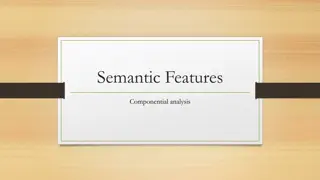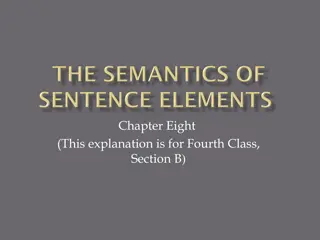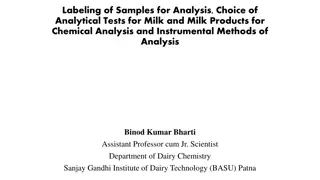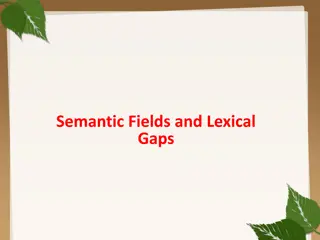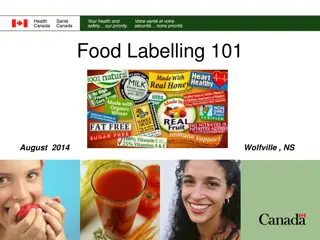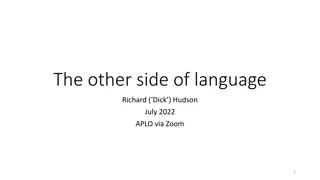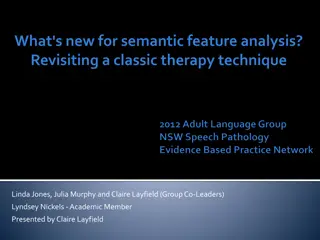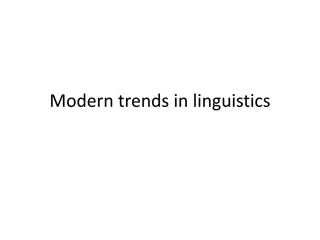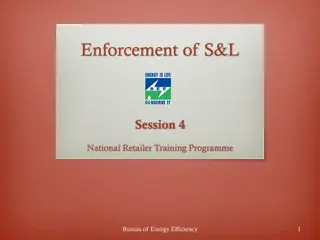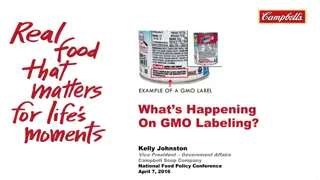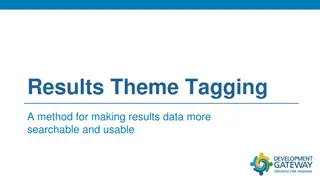Understanding Semantic Role Labeling and Thematic Roles in Linguistics
Exploring Semantic Role Labeling, a crucial aspect of linguistics, which involves assigning roles to words in a sentence to understand their relationships. Delve into thematic roles that capture the commonality between actions and objects in language, tracing back to ancient linguistic models and modern formulations.
Download Presentation

Please find below an Image/Link to download the presentation.
The content on the website is provided AS IS for your information and personal use only. It may not be sold, licensed, or shared on other websites without obtaining consent from the author. Download presentation by click this link. If you encounter any issues during the download, it is possible that the publisher has removed the file from their server.
E N D
Presentation Transcript
Semantic Role Labeling
Semantic Role Labeling Introduction
Applications Semantic Role Labeling Question & answer systems Who did what to whom at where? The police officer detained the suspect at the scene of the crime V ARG2 Theme ARG0 Agent AM-loc Location Predicate 30
Can we figure out that these have the same meaning? XYZ corporation bought the stock. They sold the stock to XYZ corporation. The stock was bought by XYZ corporation. The purchase of the stock by XYZ corporation... The stock purchase by XYZ corporation... 4
A Shallow Semantic Representation: Semantic Roles Predicates (bought, sold, purchase) represent an event semantic roles express the abstract role that arguments of a predicate can take in the event More specific More general agent buyer proto-agent 5
Semantic Role Labeling Semantic Roles
Getting to semantic roles Neo-Davidsonian event representation: Sasha broke the window Pat opened the door Subjects of break and open: Breaker and Opener Deep roles specific to each event (breaking, opening) Hard to reason about them for NLU applications like QA 7
Thematic roles Breaker and Opener have something in common! Volitional actors Often animate Direct causal responsibility for their events Thematic roles are a way to capture this semantic commonality between Breakers and Eaters. They are both AGENTS. The BrokenThing and OpenedThing, are THEMES. prototypically inanimate objects affected in some way by the action 8
Thematic roles One of the oldest linguistic models Indian grammarian Panini between the 7th and 4th centuries BCE Modern formulation from Fillmore (1966,1968), Gruber (1965) Fillmore influenced by Lucien Tesni re s (1959) E l ments de Syntaxe Structurale, the book that introduced dependency grammar Fillmore first referred to roles as actants (Fillmore, 1966) but switched to the term case 9
Thematic roles A typical set: 10
Thematic grid, case frame, -grid thematic grid, case frame, -grid Break: AGENT, THEME, INSTRUMENT. Example usages of break Some realizations: 11
Diathesis alternations (or verb alternation) Break: AGENT, INSTRUMENT, or THEME as subject Give: THEME and GOAL in either order Dative alternation: particular semantic classes of verbs, verbs of future having (advance, allocate, offer, owe), send verbs (forward, hand, mail), verbs of throwing (kick, pass, throw), etc. Levin (1993): 47 semantic classes ( Levin classes ) for 3100 English verbs and alternations. In online resource VerbNet. 12
Problems with Thematic Roles Hard to create standard set of roles or formally define them Often roles need to be fragmented to be defined. Levin and Rappaport Hovav (2015): two kinds of INSTRUMENTS intermediaryinstruments that can appear as subjects The cook opened the jar with the new gadget. The new gadget opened the jar. enabling instruments that cannot Shelly ate the sliced banana with a fork. *The fork ate the sliced banana. 13
Alternatives to thematic roles 1. Fewer roles: generalized semantic roles, defined as prototypes (Dowty 1991) PROTO-AGENT PROTO-PATIENT PropBank 2. More roles: Define roles specific to a group of predicates FrameNet 14
Semantic Role Labeling The Proposition Bank (PropBank)
PropBank Palmer, Martha, Daniel Gildea, and Paul Kingsbury. 2005. The Proposition Bank: An Annotated Corpus of Semantic Roles. Computational Linguistics, 31(1):71 106 16
PropBank Roles Following Dowty 1991 Proto-Agent Volitional involvement in event or state Sentience (and/or perception) Causes an event or change of state in another participant Movement (relative to position of another participant) Proto-Patient Undergoes change of state Causally affected by another participant Stationary relative to movement of another participant 17
PropBank Roles Following Dowty 1991 Role definitions determined verb by verb, with respect to the other roles Semantic roles in PropBank are thus verb-sense specific. Each verb sense has numbered argument: Arg0, Arg1, Arg2, Arg0: PROTO-AGENT Arg1: PROTO-PATIENT Arg2: usually: benefactive, instrument, attribute, or end state Arg3: usually: start point, benefactive, instrument, or attribute Arg4 the end point (Arg2-Arg5 are not really that consistent, causes a problem for labeling) 18
Advantage of a ProbBank Labeling This would allow us to see the commonalities in these 3 sentences: 20
Modifiers or adjuncts of the predicate: Arg-M ArgM- 21
PropBanking a Sentence PropBank - A TreeBanked Sentence (S (NP-SBJ Analysts) (VP have (VP been (VP expecting (NP (NP a GM-Jaguar pact) (SBAR (WHNP-1 that) Martha Palmer 2013 S A sample parse tree VP have VP (S (NP-SBJ *T*-1) (VP would (VP give (NP the U.S. car maker) (NP (NP an eventual (ADJP 30 %) stake) (PP-LOC in (NP the British company)))))))))))) NP-SBJ been VP Analysts expecting NP SBAR NP S a GM-Jaguar pact WHNP-1 VP that NP-SBJ VP *T*-1 would NP give NP PP-LOC Analysts have been expecting a GM-Jaguar pact that would give the U.S. car maker an eventual 30% stake in the British company. NP the US car maker NP an eventual 30% stake in the British company 22
The same parse tree PropBanked The same sentence, PropBanked Martha Palmer 2013 (S Arg0 (NP-SBJ Analysts) (VP have (VP been (VP expecting Arg1 (NP (NP a GM-Jaguar pact) (SBAR (WHNP-1 that) (S Arg0 (NP-SBJ *T*-1) (VP would (VP give Arg2 (NP the U.S. car maker) Arg1 (NP (NP an eventual (ADJP 30 %) stake) (PP-LOC in (NP the British company)))))))))))) that would give Arg1 have been expecting Arg1 Arg0 a GM-Jaguar pact Analysts Arg0 *T*-1 an eventual 30% stake in the British company Arg2 the US car maker expect(Analysts, GM-J pact) give(GM-J pact, US car maker, 30% stake) 23
Verb Frames Coverage By Language Current Count of Senses (lexical units) Annotated PropBank Data 2013 Verb Frames Coverage Count of word sense (lexical units) Penn English TreeBank, OntoNotes 5.0. Total ~2 million words Penn Chinese TreeBank Hindi/Urdu PropBank Arabic PropBank Estimated Coverage in Running Text 99% 98% 99% Language Final Count English Chinese Arabic 10,615* 24, 642 7,015 Only 111 English adjectives From Martha Palmer 2013 Tutorial 24 54
Plus nouns and light verbs English Noun and LVC annotation !Example Noun: Decision !Roleset: Arg0: decider, Arg1: decision ! [yourARG0] [decisionREL] [to say look I don't want to go through this anymoreARG1] !Example within an LVC: Make a decision ! [the PresidentARG0] [madeREL-LVB] the [fundamentally correctARGM-ADJ] [decisionREL] [to get on offenseARG1] Slide from Palmer 2013 25 57
Semantic Role Labeling FrameNet
Capturing descriptions of the same event by different nouns/verbs 27
FrameNet Baker et al. 1998, Fillmore et al. 2003, Fillmore and Baker 2009, Ruppenhofer et al. 2006 Roles in PropBank are specific to a verb Role in FrameNet are specific to a frame: a background knowledge structure that defines a set of frame-specific semantic roles, called frame elements, includes a set of pred cates that use these roles each word evokes a frame and profiles some aspect of the frame 28
The Change position on a scale Frame This frame consists of words that indicate the change of an ITEM s position on a scale (the ATTRIBUTE) from a starting point (INITIAL VALUE) to an end point (FINALVALUE) 29
Relation between frames Inherits from: Is Inherited by: Perspective on: Is Perspectivized in: Uses: Is Used by: Subframe of: Has Subframe(s): Precedes: Is Preceded by: Is Inchoative of: Is Causative of: 32
Relation between frames cause change position on a scale Is Causative of: Change_position_on_a_scale Adds an agent Role add.v, crank.v, curtail.v, cut.n, cut.v, decrease.v, development.n, diminish.v, double.v, drop.v, enhance.v, growth.n, increase.v, knock down.v, lower.v, move.v, promote.v, push.n, push.v, raise.v, reduce.v, reduction.n, slash.v, step up.v, swell.v 33
Relations between frames EVENT Event Place TRANSITIVE_ACTION Event CAUSE_TO_MAKE_NOISE Purpose MAKE_NOISE Sound Time event.n, happen.v, occur.v, take place.v, ... Place Place Place Time Time Time OBJECTIVE_INFLUENCE Place Agent Agent Noisy_event Cause Cause Sound_source cough.v, gobble.v, hiss.v, ring.v, yodel.v, ... Time Patient Sound_maker blare.v, honk.v, play.v, ring.v, toot.v, ... Influencing_entity Influencing_situation Dependent_entity affect.v, effect.n, impact.n, impact.v, ... Inheritance relation Causative_of relation Excludes relation Figure CAUSE TO MAKE NOISE frame, from the FrameNet lexicon. ovals. Non-core roles (such as Place and Time) as unfilled ovals. No particular signifi- cance isascribed to the ordering of a frame s roles in its lexicon entry (the selection and ordering of rolesaboveisfor illustativeconvenience). CAUSE TO MAKE NOISE defines a total of 14 roles, many of them not shown here. 2: Partial illustration of frames, roles, and LUs Core roles are filled related to the 34 Figure from Das et al 2010 data that does not correspond to an LU for the frame it evokes. Each frame definition also includes a set of frame elements, or roles, corresponding to different aspects of the concept represented by the frame, such as participants, props, and attributes. We use the term argument to refer to a sequence of word tokens annotated as filling a frame role. Fig. 1 shows an example sentence from the training data with annotated targets, LUs, frames, and role-argument pairs. TheFrameNet lexicon also provides information about relations between frames and between roles (e.g., INHERITANCE). Fig. 2 shows a subset of therelations between threeframesand their roles. Accompanying most frame definitions in the FrameNet lexicon is a set of lexico- graphic exemplar sentences(primarily from theBritish National Corpus) annotated for that frame. Typically chosen to illustrate variation in argument realization patterns for the frame in question, these sentences only contain annotations for a single frame. We found that using exemplar sentences directly to train our models hurt performance as evaluated on SemEval 07 data, even though the number of exemplar sentences isan or- der of magnitude larger than the number of sentences in our training set ( 2.2). This is presumably because theexemplars areneither representative asa sample nor similar to thetest data. Instead, wemakeuseof theseexemplars in features( 4.2). 2.2 Data Our training, development, and test sets consist of documents annotated with frame- semantic structures for the SemEval 07 task, which we refer to collectively as the SemEval 07 data.3For the most part, the frames and roles used in annotating these documents were defined in the FrameNet lexicon, but there are some exceptions for which theannotators defined supplementary framesand roles; theseareincluded in the 3The full-text annotations and other resources for the 2007 task are available at ht t p: / / f r am enet . i csi . ber kel ey. edu/ sem eval / FSSE. ht m l . 4
Schematic of Frame Semantics Figure from Das et al (2014) 35
FrameNet Complexity From Das et al. 2010 36
Semantic Role Labeling Semantic Role Labeling Algorithm
Semantic role labeling (SRL) The task of finding the semantic roles of each argument of each predicate in a sentence. FrameNet versus PropBank: 39
History Semantic roles as a intermediate semantics, used early in machine translation (Wilks, 1973) question-answering (Hendrix et al., 1973) spoken-language understanding (Nash-Webber, 1975) dialogue systems (Bobrow et al., 1977) Early SRL systems Simmons 1973, Marcus 1980: parser followed by hand-written rules for each verb dictionaries with verb-specific case frames (Levin 1977) 40
Why Semantic Role Labeling A useful shallow semantic representation Improves NLP tasks like: question answering Shen and Lapata 2007, Surdeanu et al. 2011 machine translation Liu and Gildea 2010, Lo et al. 2013 41
How do we decide what is a predicate If we re just doing PropBank verbs Choose all verbs Possibly removing light verbs (from a list) If we re doing FrameNet (verbs, nouns, adjectives) Choose every word that was labeled as a target in training data 43
Features Headword of constituent Examiner Headword POS NNP Voice of the clause Active Subcategorization of pred VP -> VBD NP PP Named Entity type of constit ORGANIZATION First and last words of constit The, Examiner Linear position,clause re: predicate before 45
Path Features Path in the parse tree from the constituent to the predicate 46
Frequent path features 47 From Palmer, Gildea, Xue 2010
Final feature vector For The San Francisco Examiner , Arg0, [issued, NP, Examiner, NNP, active, before, VP NP PP, ORG, The, Examiner, ] Other features could be used as well sets of n-grams inside the constituent other path features the upward or downward halves whether particular nodes occur in the path 48
3-step version of SRL algorithm 1. Pruning: use simple heuristics to prune unlikely constituents. 2. Identification: a binary classification of each node as an argument to be labeled or a NONE. 3. Classification: a 1-of-N classification of all the constituents that were labeled as arguments by the previous stage 49
Why add Pruning and Identification steps? Algorithm is looking at one predicate at a time Very few of the nodes in the tree could possible be arguments of that one predicate Imbalance between positive samples (constituents that are arguments of predicate) negative samples (constituents that are not arguments of predicate) Imbalanced data can be hard for many classifiers So we prune the very unlikely constituents first, and then use a classifier to get rid of the rest. 50




